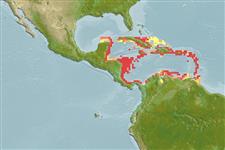Environment: milieu / climate zone / depth range / distribution range
Ecología
marino; agua dulce; salobre; rango de profundidad 0 - 50 m (Ref. 189). Tropical; 23°N - 7°N, 90°W - 60°W (Ref. 189)
Western Central Atlantic: Cuba and Jamaica to at least Puerto Rico, if not throughout Lesser Antilles; Yucatan (Mexico) to Colombia, Venezuela and Trinidad, but apparently not further south.
Tamaño / Peso / Age
Maturity: Lm ? range ? - ? cm
Max length : 9.1 cm TL macho / no sexado; (Ref. 80009); common length : 5.0 cm TL macho / no sexado; (Ref. 5217)
Espinas dorsales (total) : 0; Espinas anales: 0; Radios blandos anales: 17 - 22. Snout moderate, a little over 1/2 eye diameter; maxilla moderate, tip sharply pointed, reaching to or a little beyond hind border of pre-operculum; gill cover canals of walkeri-type. Anal fin fairly short, its origin before midpoint of dorsal fin base. Anus nearer to pelvic fin tips than to anal fin origin. A narrow silver stripe along flank about eye diameter (Ref. 189).
A schooling species occurring in coastal waters. Enters saline lagoons, and, if identified properly, then also in freshwater (e.g. the middle and upper flights of the Gatun Locks, Canal Zone). Feeds on plankton (Ref. 5217).
Life cycle and mating behavior
Madurez | Reproducción | Puesta | Huevos | Fecundidad | Larva
Spawn in school (Ref. 205).
Whitehead, P.J.P., G.J. Nelson and T. Wongratana, 1988. FAO Species Catalogue. Vol. 7. Clupeoid fishes of the world (Suborder Clupeoidei). An annotated and illustrated catalogue of the herrings, sardines, pilchards, sprats, shads, anchovies and wolf-herrings. FAO Fish. Synop. 125(7/2):305-579. Rome: FAO. (Ref. 189)
IUCN Red List Status (Ref. 130435: Version 2024-1)
Threat to humans
Harmless
Human uses
Pesquerías: escaso valor comercial; carnada: usually
Herramientas
Special reports
Download XML
Fuentes de Internet
Estimates based on models
Preferred temperature (Ref.
123201): 26.8 - 28.3, mean 27.7 °C (based on 74 cells).
Phylogenetic diversity index (Ref.
82804): PD
50 = 0.5000 [Uniqueness, from 0.5 = low to 2.0 = high].
Bayesian length-weight: a=0.00468 (0.00268 - 0.00815), b=3.16 (3.02 - 3.30), in cm total length, based on LWR estimates for this species & Genus-body shape (Ref.
93245).
Nivel trófico (Ref.
69278): 3.3 ±0.4 se; based on diet studies.
Resiliencia (Ref.
120179): Alto, población duplicada en un tiempo mínimo inferior a 15 meses (Preliminary K or Fecundity.).
Fishing Vulnerability (Ref.
59153): Low vulnerability (10 of 100).
